Fronted adverbials – Best KS2 worksheets, examples and lesson ideas

Once upon a time, pupils weren't expected to know what a fronted adverbial was. Today's students, however, very much are, and hopefully these resources can help…

- by Laura Dobson
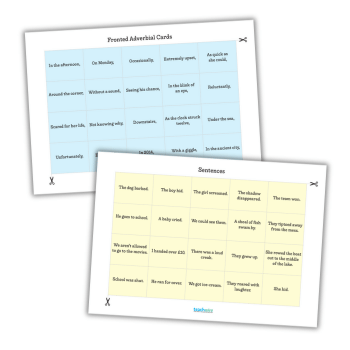
In lockdown and the era of homeschooling, Michael Rosen noted that his social media timeline was suddenly full of parents telling him that they didn’t know what fronted adverbials were.
If you’re also confused or need fresh inspiration for teaching this area of grammar, read on…
What are fronted adverbials?
The 2014 national curriculum glossary explains that when we move a word or phrase that normally comes after a verb to before it, we have ‘fronted’ it.
It defines an adverbial as a word or phrase that we use, like an adverb, to modify a verb or clause.
We can use adverbs as adverbials. However, you can also use many other types of words and phrases this way, including preposition phrases and subordinate clauses.
For children (and teachers) to understand adverbials, they need to understand word classes more generally. All sentences will have a subject and a verb: ‘The dog barked.’ They may even have an object too: ‘The dog barked at the cat.’
It would be hard to write this sentence in a different order and retain the same level of coherence. An adverbial, however, is very flexible. ‘The dog barked at the cat at 11am.’ Here the adverbial (‘at 11am’) is after the verb (‘barked’).
‘At 11am, the dog barked at the cat.’ Here we have fronted it. Personally, I think it works better fronted in this sentence, otherwise we’re using ‘at’ twice in quick succession. But there are other occasions when the adverbial sounds better after the verb.
The role of adverbials
Adverbials tell us more about the verb. They might tell us when, where, how, how long, why or how much. They add an extra level of detail to our sentences. You may find more than one in a sentence: ‘In 2020, at the age of 100, Captain Tom was finally knighted.’
Have a go at moving these adverbials around. Notice how you can make this sentence look quite different, but it’s still coherent and has the same meaning. That’s the wonderful thing about adverbials!
High-quality model texts
Teach fronted adverbials in context with these creative and powerful model texts from Plazoom for Year 4. Each text is annotated with key teaching points and will save you hours of time writing or finding your own examples.
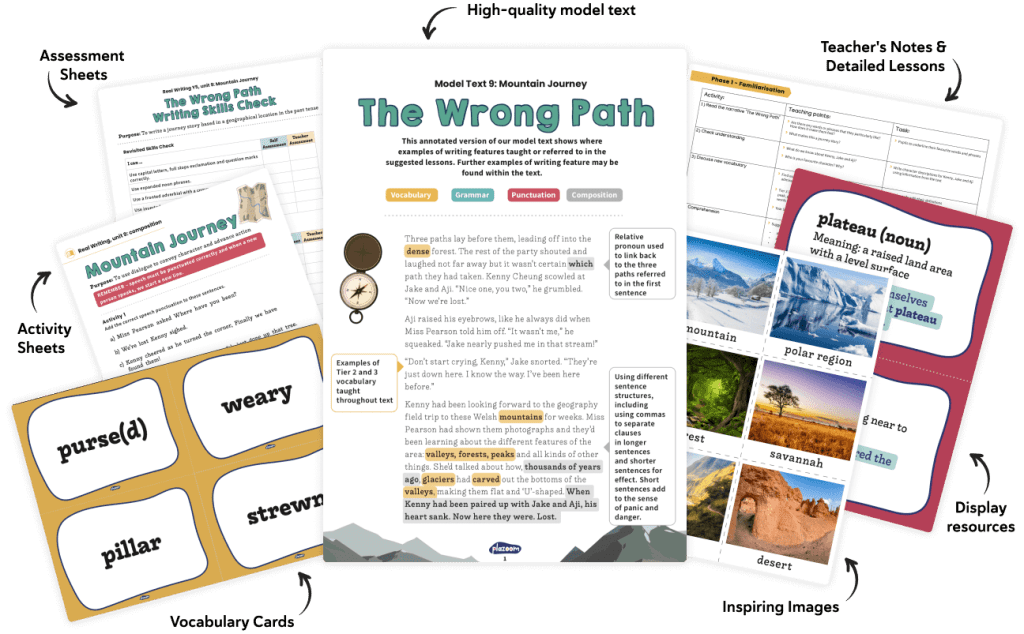
Fronted adverbials examples
- ‘Save Our Ancient Woodlands‘ protest letter by Loretta Schauer – explore the author’s use of fronted adverbials in discursive writing
- ‘Until We Are Free Again‘ exciting narrative by Margeret Bateson-Hill – write a description of Boudicca using adverbials to show time, place and manner
- ‘Dear Gran‘ informal recount by Jo Franklin – investigate how to use fronted adverbials to modify verbs
How to teach fronted adverbials
The best way to teach children about fronted adverbials is to look at them being used by experts: children’s authors. Pick up any good children’s chapter book (and many picturebooks too) and you’re bound to spot a fronted adverbial on whichever page the book falls open at.
“The best way to teach children about fronted adverbials is to look at them being used by experts”
You’ll undoubtedly also find a sentence which starts with a determiner. This is good because we want children to see that fronted adverbials work best when used as one way to start a sentence, not the only way. Variety is the spice of life, after all.
When looking at a children’s book, select a sentence which includes a fronted adverbial and discuss it. I’ve chosen the excellent Fergus Crane by Paul Stewart and Chris Riddell for my example:
‘Further along the road, the air swirled with mournful music.’
Discussions about word class should form a normal part of a lesson. Identifying verbs and nouns allows children to see when a sentence isn’t complete.
If they’re unable to spot a verb and realise that a sentence requires one, you’ll find incomplete sentences making their way into children’s writing, like ‘Further along the road, a girl with long, blonde hair’.
Play around with the adverbial from Fergus Crane. Can we place it anywhere else in the sentence? Why have the authors decided to write it like this? Identify what it tells us about the verb ‘swirled’.
Once children understand what fronted adverbials are, what they can add to a sentence and have examined them in real writing, then it’s time to have some fun as writers.
Effective use
Once children have seen real examples of fronted adverbials in writing and have experimented with them they will inevitably be on the success criteria for a writing lesson.
Hopefully, you will have instilled in your class the importance of variety in sentence openers and structures. They will have seen, both in real writing and in your modelling, the importance of using fronted adverbials alongside a whole plethora of ways sentences can be written.
When we mark children’s work, we must congratulate effective writing decisions and not simply praise a grammatical structure being used.
Children need to understand what a fronted adverbial is, how it can be used and the effect it can have. They also need to know when it works and when it doesn’t.
Trending
“We must congratulate effective writing decisions and not simply praise a grammatical structure being used”
Take a look at the following examples:
- As quick as a flash, the tortoise headed to the lettuce
- All of a sudden, the old boat slowly began to appear on the horizon.
- Quietly, the boy said his name with a booming voice.
Excellent fronted adverbials and excellent sentences, but together they do not work. The grammatical skills we teach explicitly will provide children with an excellent toolkit as they become proficient writers if we teach that skill within its context.
Laura Dobson is a teaching and learning consultant with a passion for primary English.
Fronted adverbials teaching resources
Fronted adverbial games
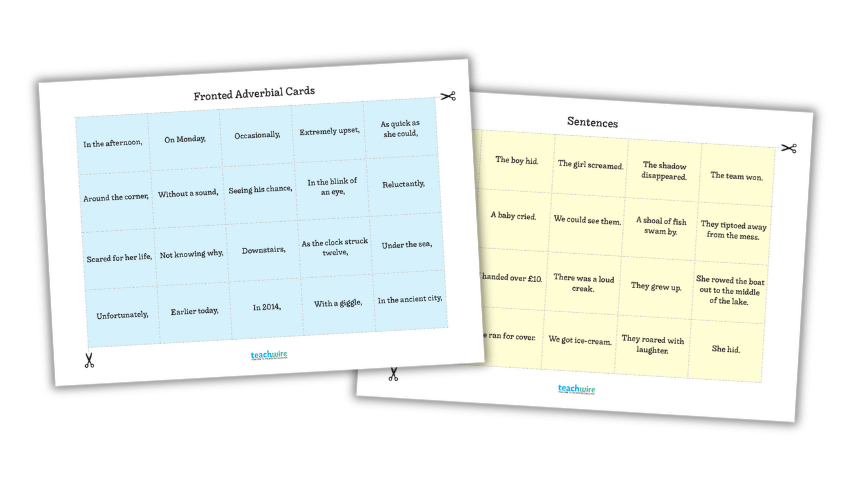
Download our fronted adverbials word mats and cut up the fronted adverbial cards and the example sentences.
Game 1
Ask children to get into pairs. Each child needs to select a blue card and a yellow card. If the fronted adverbial makes sense with the sentence, they get a point.
Game 2
Get pupils to sort the pairs they make into the following categories:
- makes sense
- makes sense but silly
- nonsense
As a further challenge, ask children to explain why the sentence is silly or why it’s nonsense.
Game 3
This resource can also be used with just the fronted adverbial cards. In groups of three, ask children to turn over one card. Two pupils must then have a go at completing the sentence. The third child votes for which sentence they prefer and explains why.
Game 4
Finally, this resource can be used to consider how flexible adverbials are within a sentence. In pairs, ask children to select an adverbial and a sentence. How many ways can they write the sentence with the adverbial in, and still achieve the same meaning?
A word of warning: both the fronted adverbial cards and the sentences begin with capital letters. As they play around with these, they must remember to remove the capital letter that is not required.
Fronted adverbials SPaG challenge mat
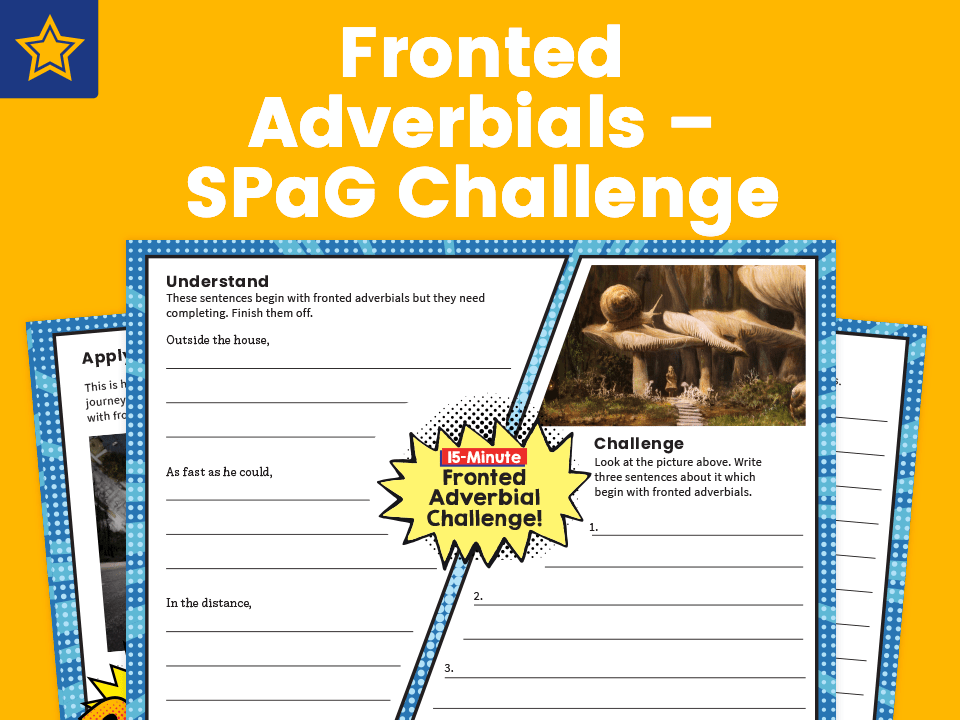
This review mat for grammar, punctuation and spelling from Plazoom is an excellent way to revise and practise using fronted adverbials. The worksheets are divided into five different types of activity, including writing challenges and GPS sample test questions.
Fronted adverbials spinner
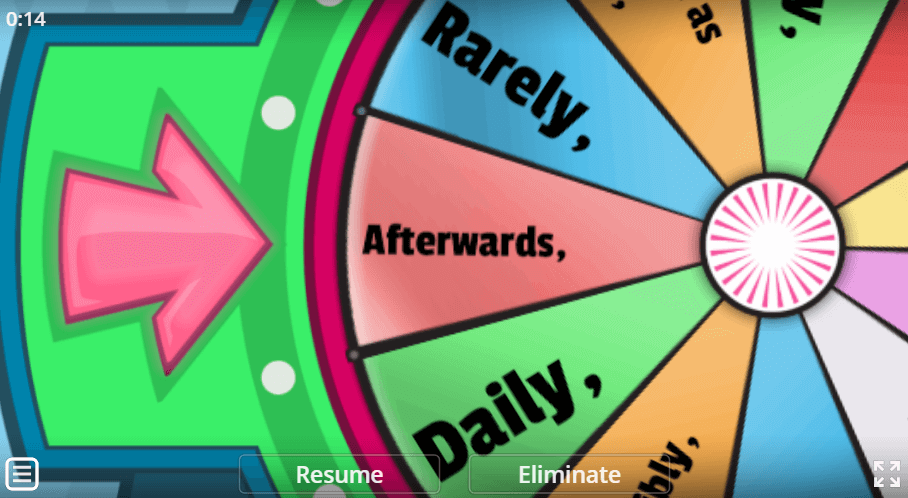
This simple interactive resource spins a virtual wheel full of fronted adverbials. You can then challenge students to write a sentence starting with their word.
All about that verb
If you’re after a catchy song to try to help kids retain information about what an adverb does, this little ditty is set to the tune of ‘All About That Bass’, so it’s likely to be a hit with primary students.
Adverbs word mat
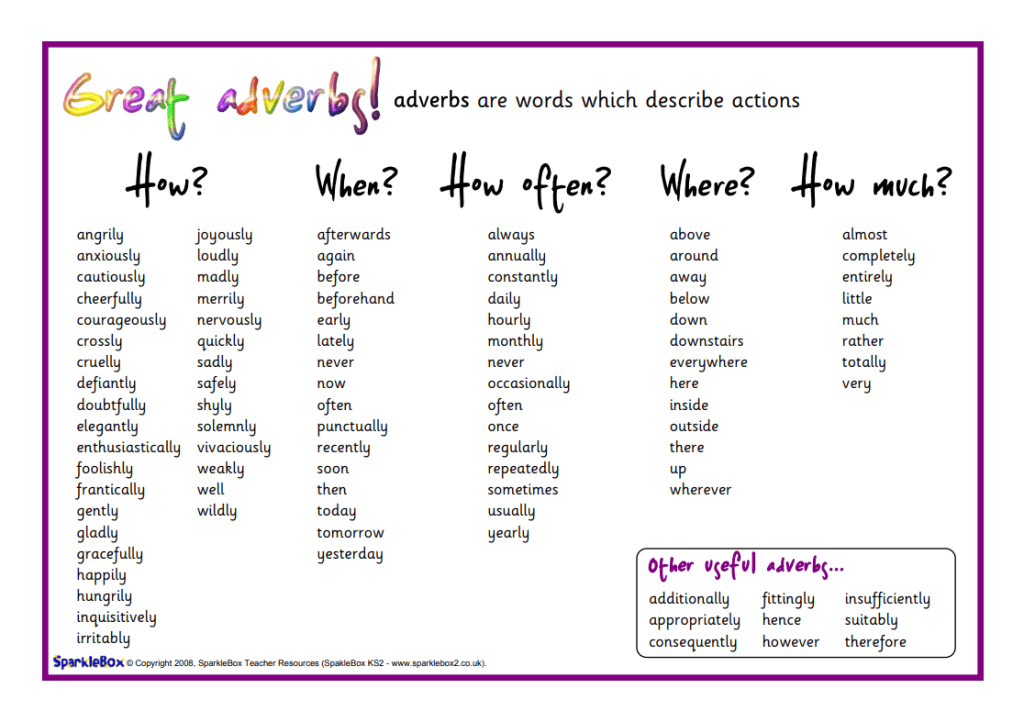
This handy adverb word mat groups each term into ‘How?’, ‘When?’, ‘How Often?’, ‘Where?’ and ‘How much?’. It’s a good place for kids to start when looking for inspiration to create their own sentences.
Fronted adverbials guide and games
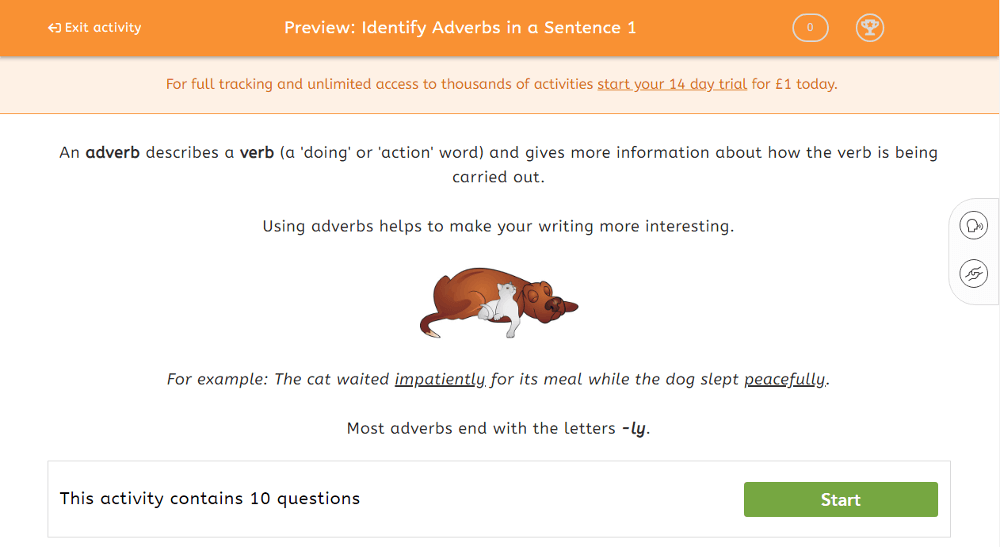
This handy article from EdPlace runs through what fronted adverbials are, gives some examples, offers some activities to try and includes some interactive online worksheets to use.
Fronted football adverbials
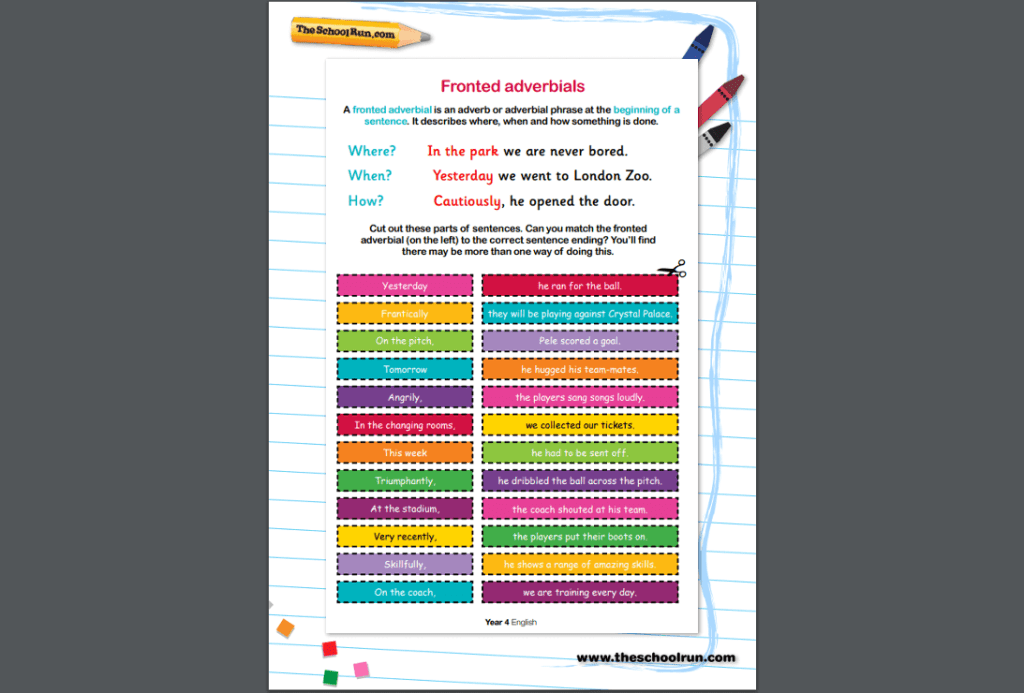
For something a little more hands on, this printable PDF has a range of cut-out sentence openers and endings to match up, all linked to a football theme.
Cutting edge classroom ideas
This activity from a teacher on Vimeo involves printing out a selection of sentences that require the students to find the verb or verb phrase, then cutting out the adverb or adverbial and moving it to the front of the sentence (adding a comma if necessary).
Worksheet with answers
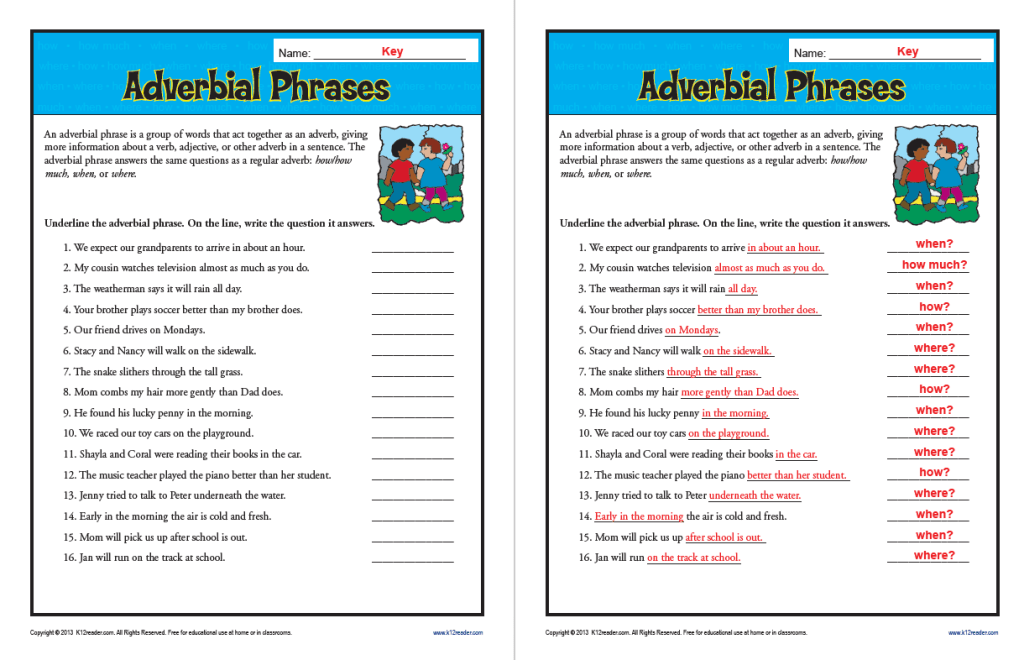
Rather than the usual reorganising of sentences, this worksheet asks students to identify the adverbial, and then write down whether each one falls under the category of ‘how/how much’, ‘when’, or ‘where’.
Of course, you could always get them to rearrange the sentences so that they include fronted adverbials afterwards.










